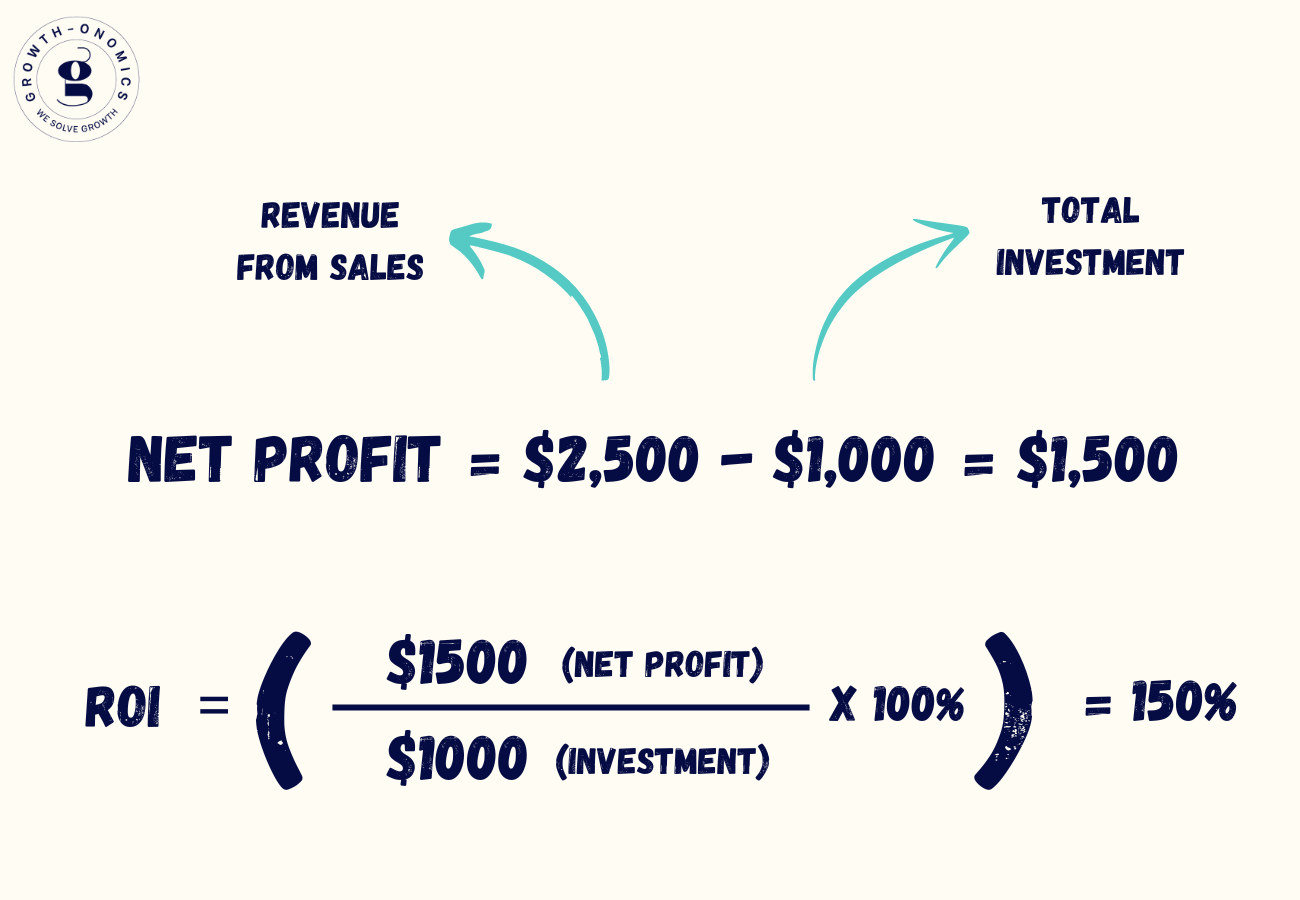Imagine spending thousands of dollars on a B2B marketing agency unaware of the metrics for measuring its success. Horrifying, right?
Fortunately, you aren’t alone in this.
Many businesses struggle to measure the return on investment (ROI) and need help estimating their B2B marketing efforts.
The truth is:
– Most Businesses Don’t Measure ROI: Shockingly, around 35% of B2B marketers rarely track ROI, reports Marketing Week. This lack of measurement is even worse for larger companies.
– Without Measurement, Most Businesses Fail: A staggering 90% of online businesses fail within the first few months due to the absence of proper metrics.
This lack of clarity is a recipe for disaster. But there’s good news!
Measuring ROI allows you to:
– See if a B2B Marketing Agency Is Delivering Value: Are you getting what you pay for? Measuring ROI lets you hold the agency accountable.
– Make Smart Marketing Decisions: Data-driven insights help you optimize your marketing spend and maximize returns.
– Increase Your Chances of Success: Companies that track ROI are 17 times more likely to see positive results.
Here’s where it gets tricky.
Measuring B2B marketing ROI is a challenging task.
B2B sales cycles are long, involve multiple decision-makers, and the impact of marketing efforts can be scattered across different touchpoints.
This makes it difficult to pinpoint exactly which ad or social media post directly led to a sale.
Don’t worry because we can help!
Use this guide to measure the ROI of your B2B marketing agency partnership, and decide whether you hire an agency or internal team.
We have covered everything you need to know, from key metrics to tools and techniques, so that you can gauge your marketing’s true impact.
And, if you are on the lookout for a great marketing agency, you can book a call with a Growth-onomics advisor:
Book a Call with Growth-onomics
Understand ROI Metrics In B2B Marketing
ROI, or Return on Investment in B2B marketing, is a performance measure of your marketing strategy’s efficiency or profitability.
In other words, it’s a measure of how much profit you make compared to the amount of money you put in.
The formula for ROI is simple:
ROI = (Revenue – Investment) / Investment x 100%
Let’s say you invest in social media advertising to promote your organic apparel brand. You spend $500 on striking social media graphics and ad copy. You allocate an extra $500 to run social media ads across different platforms.
In total, your investment for this campaign is $1,000.
The social media campaign went viral – generates a lot of buzz and convinces many eco-conscious shoppers to visit your online store. A month later, you track the campaign-related sales and discover $2,500 worth of sales.
Here’s how to calculate your ROI:

Net Profit: $2,500 (revenue from sales) – $1,000 (total investment) = $1,500
ROI: ($1,500 net profit / $1,000 investment) x 100% = 150%
This translates to a terrific ROI of 150%!
Simply put, for every dollar you invested in social media, you earned $1.50. This shows that the social media campaign worked well to reach new customers and strengthen the sales of your organic apparel brand.
What Is A Good B2B Marketing ROI?
There is no one-size-fits-all answer to what a good B2B marketing ROI is.
It depends on several factors, like:
– Your Industry: The costs and timeframes for acquiring new customers vary from industry to industry. Expect to generate more revenue from your marketing investments based on this factor.
– Your Products or Services: Your products’ complexity and cost will influence how much you’re willing to spend on customer acquisition.
– Your Online Marketing Investment: The amount you invest in marketing activities directly affects the potential return.
This is why it’s recommended to set a custom ROI goal through internal brainstorming (or with your digital marketing agency).
Consider what’s achievable based on your budget and historical data (if available) and what you ideally want to get out of your marketing efforts.
This will help you establish a realistic and aspirational ROI goal to track your progress throughout the year.
Key Steps To Measure ROI
1. Determine Aligned Goals & Measurable KPIs
Identify the goals and KPIs you and your partnered B2B marketing agency agreed to. It is marketing goals and KPIs aligned with marketing efforts that result in a positive ROI.
Align them and determine whether your goal is to generate qualified leads, increase brand awareness, or achieve a specific sales target.
Once you have determined your goal and worked with your B2B marketing agency to translate it into measurable KPIs, it’s time to assess ROI.
For example, your KPI would be qualified leads generated per month if your goal was lead generation.
For sales, however, your KPI would be revenue generated from marketing-qualified leads (MQLs).
2. Track Marketing Costs
For an accurate ROI measurement, it is crucial to consider all the costs associated with your B2B marketing agency partnership.
This includes:
– Agency fees: The retainer or project-based fees paid to the marketing agency for their services.
– Campaign-specific costs: Expenses associated with specific marketing activities the agency performs, such as social media or search engine advertising.
Both of the above costs are “direct costs”.
– Marketing technology subscriptions: Agency costs associated with marketing automation and analytics tools used in campaigns.
This one falls under indirect cost.
– Internal resources allocated: Include the time and effort your internal marketing team devotes to collaborating with the agency.
Remember: A thorough understanding of total marketing expenditures is essential to calculating an accurate ROI.
3. Understand Attribution Models
An attribution model helps determine which marketing activities contributed to a conversion.
Let’s say, you run an ad on LinkedIn and a potential customer sees it, clicks through to your website, downloads a white paper, and then follows up with a nurturing email before reaching out to your sales team. Attributing this sale solely to the initial ad wouldn’t be accurate. This is where attribution models play a key role.
In an attribution model, credit for a conversion (e.g., a sale or lead) is based on customer interactions during the buyer’s journey.
Here are some B2B attribution models and how they apply:
– First Touch Attribution: This model attributes credit to the first touchpoint in the customer’s journey. In B2B sales, however, where consideration periods are long, the influence of the initial touchpoint might be overestimated.

– Last Touch Attribution: This model attributes credit to the previous marketing touchpoint a customer interacted with before converting. Despite its simplicity, it can overshadow the importance of earlier touchpoints.

– Multi-Touch Attribution: This model assigns credit across all touchpoints that a customer interacts with, offering a more holistic view of the customer journey. Implementing it, however, requires robust marketing analytics tools.

Note: The most appropriate attribution model for your B2B marketing will depend on your sales cycle and marketing strategy.
You are better off discussing attribution models with your agency upfront so that transparency is maintained and attribution can be assessed accurately.
4. Measure Results & Calculate ROI
Now that you understand the marketing costs and attribution model, it’s time to do the math!
Here’s how you can calculate the ROI of your B2B marketing agency partnership:
1. Decide on a timeframe to assess ROI: Select a timeframe (e.g., quarter, year) to gauge the agency’s impact.
2. Gather data on revenue generated from marketing efforts: Collaborate with your sales team to determine the revenue attributable to marketing. This might include sales-qualified leads the agency generated or deals closed through marketing campaigns.
3. Estimate the total marketing expenditures associated with the agency partnership: Sum up all the costs mentioned earlier, including agency fees, campaign-specific expenses, marketing technology subscriptions, and internal resources.
4. Utilize the ROI formula: Once you have your revenue and marketing spend figures, use it to calculate ROI:
(Revenue Generated from Marketing Efforts – Total Marketing Spend) / Total Marketing Spend x 100%)
5. Analyze ROI and interpret the results: A positive ROI indicates a successful marketing agency partnership. The ROI, however, is just one aspect of a marketing campaign. To gain deeper insights, analyze your results along with your KPIs.
Did the agency meet its lead generation or website traffic targets?
5. Assess Qualitative Factors
While ROI is a crucial metric, it’s not the only one to consider.
Partnering with the right B2B marketing agency can yield substantial qualitative results vital to your business’s success. Here are a few important factors to consider:
– Positive brand perception: Effective Marketing campaigns can enhance your brand image and position you as a thought leader.
– Stronger customer relationships: Targeted marketing efforts foster customer relationships and strengthen existing ones.
– Enhanced marketing efficiency: B2B marketing agencies often bring specialized expertise and access to advanced tools, facilitating marketing automation.
– Streamlined internal processes: Agencies handle day-to-day marketing tasks, freeing up your internal team to focus on core business activities.
6. Now Optimize Your Investments With Continuous Improvement
The best B2B marketing agencies are collaborative and constantly evolving.
For maximum ROI, follow these actionable tips:
– Maintain open communication & regular reporting: Schedule regular meetings with your agency to discuss campaign performance, results, and emerging market trends.
– Conduct A/B testing with data insights and adjust strategies accordingly: Experiment with different marketing strategies. With A/B testing, you can compare different tactics and optimize your campaigns.
– Foster a culture of data-driven decision-making: Make data-driven decisions a priority. Track campaign performance with marketing analytics tools and make informed adjustments as needed.
– Revisit & refine goals, KPIs based on evolving market conditions: B2B is a dynamic industry in constant flux. Regularly revisit your marketing goals and KPIs to ensure they remain aligned with your ever-changing business needs.
7. Tools & Resources For Measuring ROI
Analytics Platforms
Tools like Google Analytics, HubSpot, and Salesforce make it super easy for marketers to track and analyze their marketing efforts. They provide valuable data on website traffic, lead generation, and conversion rates.
Marketing Automation Tools
Marketing automation tools such as Marketo and Pardot automate tracking marketing efforts and their results. Manage campaigns, score leads, and nurture prospects with their assistance.
Data Integration
To measure ROI accurately, it is crucial to integrate data from multiple sources. Tools like Zapier and Segment can help consolidate data from different platforms, providing a holistic view of your marketing performance.
Conclusion
Measuring the ROI of your B2B marketing efforts is not just a numbers game; it’s a strategic imperative for driving sustainable business growth.
By setting clear, measurable objectives aligned with overall business goals, and tracking marketing expenditures/revenues using advanced analytics tools, you can gain invaluable insights into the performance of your marketing initiatives.
To maximize the return on your marketing investment, data-driven optimization is essential. Embrace an ROI-driven culture and your decisions will lead to smart choices, efficient resource allocation, and competitive advantage.
Start measuring your ROI today to maximize the impact of your marketing initiatives.
Book a Call with Growth-onomics









